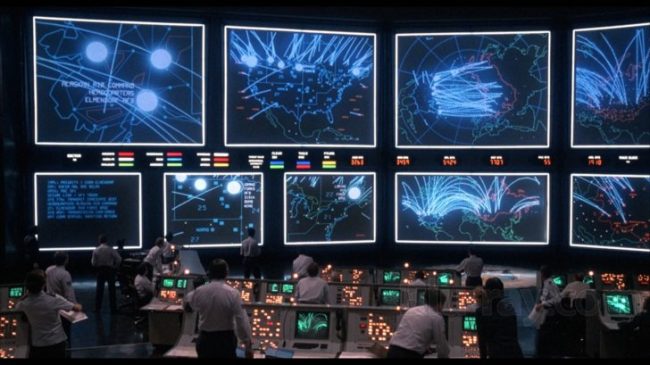
The Movie Tourist Visits NORAD in WarGames (1983)
Take a trip to one of the most celebrated military complexes at the movies.
The Movie Tourist is a series where we visit unique locations in famous films, to dig a little deeper and uncover the greatest places in movie history. Next up, WarGames, the classic cold eard thriller.
Facing the end of the world or just wanting to hide out in one of the most secure locations in Earth? This military installation and nuclear bunker built into the mountain range under 2,000 feet of granite might just be the place to be. While it’s little surprise that it’s such a popular location in film history, home to the supercomputer WOPR, might be responsible for the very apocalypse you’re escaping.
Located under the Cheyenne Mountains in Colorado Springs, Colorado this base of operations for the North American Aerospace Defence Command (NORAD) has frequently been featured in popular culture. From providing the location from which humanity began its uprising in The Terminator franchise to most memorably being used as the base for Stargate Command on Stargate SG-1 – with the show even casting personnel from the base to play extras, which was so well-received by the base that they even named a broom cupboard Stargate Command.

While we could look at this location through any number of films, it’s John Badham’s 1983 sci-fi thriller, set against the backdrop of the Cold War, that is the most interesting. In it, young hacker David (Matthew Broderick) believes he’s hacking into a video game company before almost starting World War III. More key though, it makes NORAD a central location that is more than just recognisable location to gather key members of the military. What really makes it interesting is that here in WarGames, it also serves as the home of the military supercomputer WOPR (War Operation Plan Response).
The first thing that should be noted about this vision of NORAD is that it’s actually a lot more technologically advanced than the actual facility, especially at the time the film was released were the actual facility was still using technology from the 50’s. The set of WarGames on the other hand had millions of dollars invested in it to create what they felt it would look like, it being a working government facility, it wasn’t like the filmmakers could visit and take reference photos. In fact the set was so expensive, it held the record for a while as one of the most expensive ever constructed.

Yet so believable were the sets as being the actual NORAD, guests at the facility who were fans of the film would actually remark that the facility was much less impressive than the one they were expecting from having seen the film. This situation eventually got to become such an annoyance to the command staff that they actually revamped the command centre to make it more aesthetically pleasing and impressive. It should be noted that the tour group we see in the film was actually something that used to happen pre 9/11, though the catch was that you had to know someone based there or have some kind of government credentials, but with the tightening of security these tours were fazed out.
When it comes to killer computers, WOPR is actually on the more innocent side of things, a far cry from the likes of Hal 9000 from 2001: A Space Odyssey or Colossus from Colossus: The Forbin Project and as such probably can be more closely compared to Bomb 20 from Dark Star, a fellow single-minded entity who knows it has a job to do but doesn’t understand the consequences, which in this case is the futility of nuclear war. SPOILERS: It was never programmed to understand the concept of a draw, which it finally learns playing tic-tac-toe in arguably one of the most tense finales ever made as he runs through hundreds of games as the world hinges on the brink of nuclear war.

WOPR though was always designed to be a childlike and innocent presence making more sense that Dr. Falken (John Wood) would design him like this, especially when he named it after his son Joshua, with the interactions between Falken and his creation being more like that between a father and son than man and machine. Wood pulls double duties as both Dr. Falken and his machine, doing a great job of somehow projecting the curious innocence despite the robotic tone. On a random side note, the producers had wanted Stephen Hawking to play the role of Dr. Falken who had provided the inspiration for the character, though who knows how the scenes of Dr. Falken talking to the computer would have played out.

The machine itself is essentially a box with lots of flashing lights while Special Effects Supervisor Michael L. Fink sat inside feeding information to the screens from his Apple II. The true nature of the machine though can be even seen from the fact that it has a smiley face worked into the diodes almost as if director Badham had wanted to further reinforce its good if misguided nature. The computer we see however during the film footage of Dr. Falken was however made up of parts from an IBM AN/FSQ-7 Combat Direction Central which were in 1954 to protect the United States from attacks by Soviet bomber attacks. Weighing in at 6000 tons and so big it would take up an entire floor these systems would prove popular with production companies looking for futuristic computers when the systems were decommissioned despite their age.

While the tech might seem kind of simple today, there is a real charm to the readouts we get on the NORAD displays or even David’s hacking activity which he uses mainly for his own personal purposes such as changing his school grades, though it is kind of unnerving to see him and best friend Jennifer (Ally Sheedy) giggling about which cities to nuke over Cokes. True, they don’t know it’s for real but there is just something about them unwittingly putting humanity on the path to nuclear annihilation which is just a little scary, perhaps more so in these politically tense times so who knows how this played back when the threat of nuclear war was a very real prospect. What it did inspire though was congress creating the Computer Fraud and Abuse Act of 1984 with Kansas representative Dan Glickman even using footage from the film to further his cause. A House committee report stating:
WarGames showed a realistic representation of the automatic dialling and access capabilities of the personal computer.
Of course this wouldn’t be the first nor the last time that the government would arguably over-react to the supposed capabilities of hackers, which have (but are not limited to) the use of the Cap’n Crunch whistle given away in cereal being used for phone hacking or that famous hacker Kevin Mitnick might have – while imprisoned – caused a nuclear launch by whistling dixie down the phone line. Still it’s a handy reminder of how the film was received especially when it all looks kind of quaint now.

Unquestionably since its release, the film has gone on to generate a real cult following, especially in Silicon Valley with Google holding a screening in 2008 to celebrate the 25th anniversary of the film, while Ernest Cline made re-enacting the film part of the digital treasure hunt in his debut novel Ready Player One. Even now, the dated tech aside helps retains its charm even if you didn’t watch it back in the 80’s, which really can’t be said for many of the so-called 80’s classics if you remove the haze of childhood nostalgia. Now who just wants a nice game of chess?
